The ‘Free State’ of Maryland is an awesome place to be a birdwatcher. With the Appalachian Mountains, the Piedmont Plateau, and the Coastal Plains you’ve got a wide range of environments where our feathered friends can forage, frolic, and thrive. Today we are going to talk about the popular backyard birds of Maryland and give you the scoop on some of the local Avian species you can spot. We’ll tell you what they like to eat, where they like to hide, and more, so without further ado let’s get started. Those birds are ready and waiting to be spotted by you!
3 Categories – 436 Birds
With rugged forests and lush wetlands full of life, Maryland hosts an impressive 436 species of birds throughout the state. While we can’t possibly list them all in the space which we have for today we can introduce you to a few and divide them up usefully like this:
- Year-round Resident birds
- Birds of Spring, Summer, and Early Fall
- Fall and Winter Birds
We’ll fill each seasonal area with birds that you can see during these times as well as identification and feeding info. This should give you an edge in luring and spotting these birds but you will still have to be patient. Our feathered friends can be fickle, as we all know!
Maryland’s Year-round Resident birds
These birds love Maryland and have decided to hang their little hats here to stay for the duration. You can spot them at any time of the year, provided that you know where to look for them, and we aim to tell you that shortly. See if you can spot one of these year-round resident birds this year:
- Tufted Titmouse
- American Goldfinch
- Northern Cardinal
- European Starling
- Downy Woodpecker
Tufted Titmouse – Baeolophus bicolor
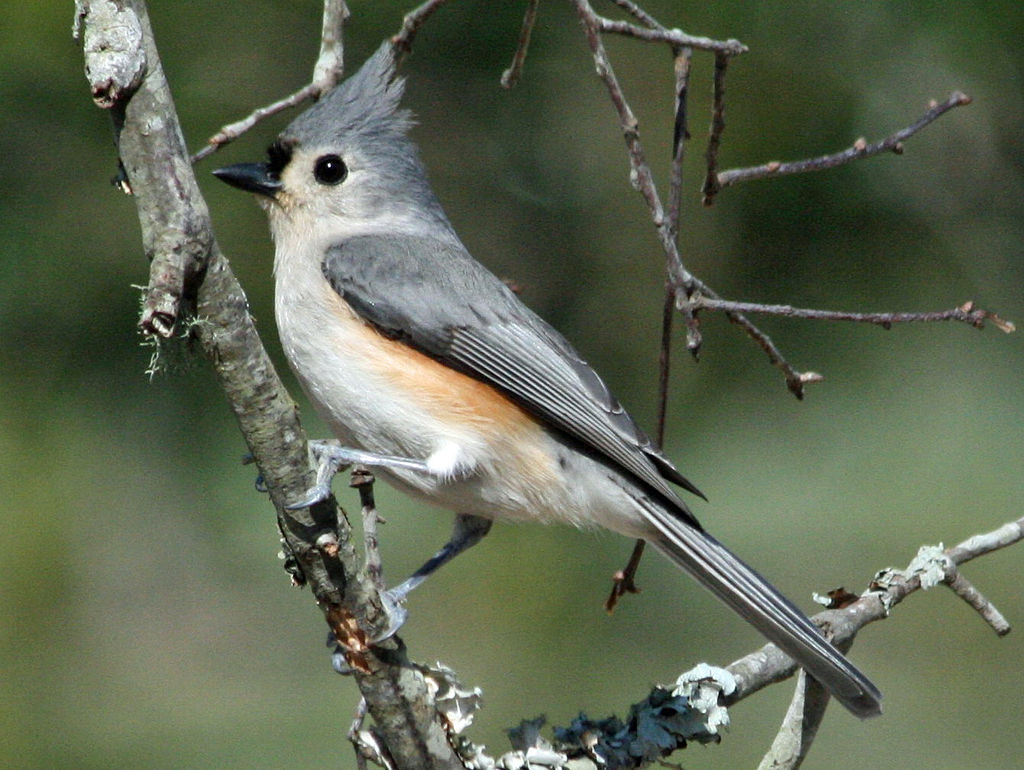
Coloration and Markings: The Tufted Titmouse has a soft blue and gray back, with medium length sings of the same color and a long, rounded tail. The breast and underbelly of this bird are white and there is a delicate flanking of peach coloration at the sides with some occasionally present in the underbelly and breast as well. It is quite light so you have to look closely. Facially, these birds have white faces with a lovely little blue crest, and some of the blue from the crest bleeds down just in front of the back of the neck down to level with its base. You will also notice an almost-square mark above the small, straight black bill. There is a noticeable curvature in the upper bill as well.
Size: These birds measure in at 5.5 – 6.3 inches in length and have a wingspan of 7.9 to 10.2 wide.
Habitat: These birds like to spend their time in lower elevations (under 2000 feet) in Evergreen and Deciduous woods. They range out quite often, visiting orchards, parks, and backyards with well-stocked feeders!
Diet: Roll up some suet cake in crunchy peanut butter and sprinkle it with Black Oil Sunflower seeds. This combination is almost irresistible to the Tufted Titmouse.
American Goldfinch – Spinus tristis

Coloration and Markings: Male American Goldfinches are bright little guys, with bright-yellow backs and long, black wings, which bear 2 white wingbars as well as an assortment of vertical and other white marking present towards the lower, inner center of the wings. They have long, thin black tails which also bear white markings and while the rump of this bird is white the breast and underbelly are bright yellow. Facially this yellow continues, broken only by the small, black forehead cap (which looks a little like a bad toupee) and a medium length, conical orange bill. Females will have more muted yellows and olive coloration in place of the black and in winter both genders adopt a brown plumage, though the wingbars will still be dimly present.
Size: These birds measure in at 4.3 – 5.1 inches from head to tail and have wingspans of 7.5 to 8.7 inches.
Habitat: These birds spend a lot of time foraging in fields and are especially fond of those in areas which are prone to flooding. If there are a lot of thistles growing in an area then you might just get Goldfinches as well. They do range out into parks, orchards, and the occasional backyard, so be sure to leave a little something out for them.
Diet: Nyjer thistle is all that you need but they do like Black Oil Sunflower seeds as well.
Northern Cardinal – Cardinalis cardinalis
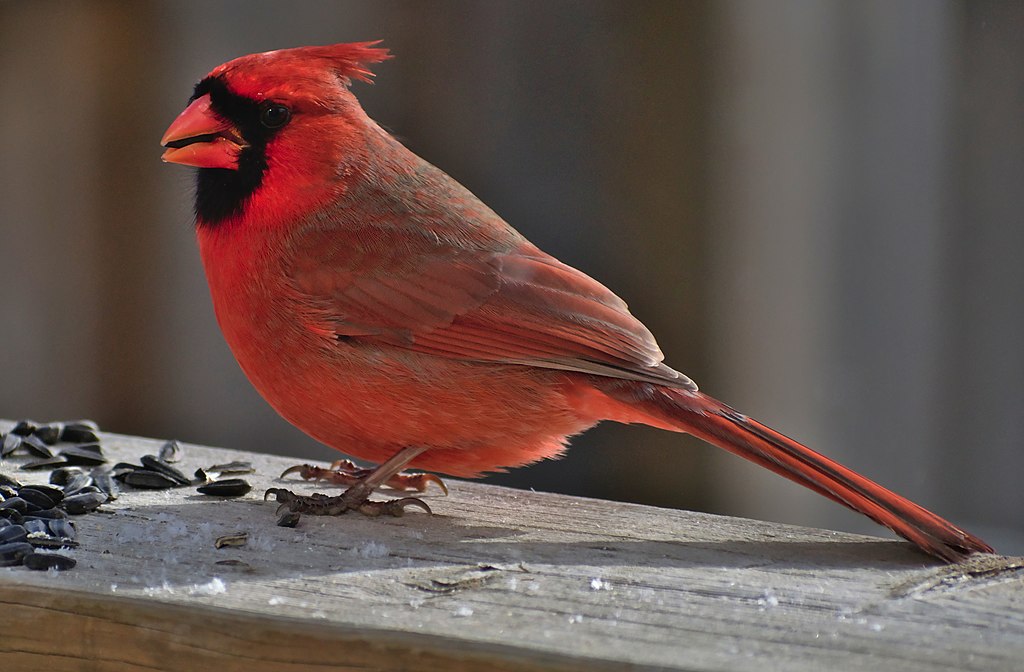
Coloration and Markings: Northern Cardinals are easy to identify but stunning nonetheless. The Males are completely red in color, with large wings which look a little small thanks to their long, red tails. Facially, you can’t miss the stunning red crest and the signature mask of the Cardinal, which not only covers the eyes but which drops sharply down to make a goatee-like mark on the bird’s chin. Females will be a soft brown but unmistakable, and you will notice reddish tinges throughout their plumage as well. These birds have large, stout, and conical orange bills. We should not that you might occasionally see some gray in the male or female’s plumage but this is likely due to molting rather than being indicative of advanced age.
Size: These birds measure in at 8.3 – 9.1 inches in length and have wingspans of 9.8 to 12.2 inches in width.
Habitat: Cardinals are ground foragers, so look for them anywhere that the vegetation gets dense. Woodlots and forest edge’s with a lot of brush are appealing to this bird. They do range out into parks and backyards, however, as these stunning red birds are big and bold.
Diet: Crushed peanuts, Safflower seeds, and cracked corn are 3 easy-to-provide favorites of the Northern Cardinal.
European Starling – Sturnus vulgaris
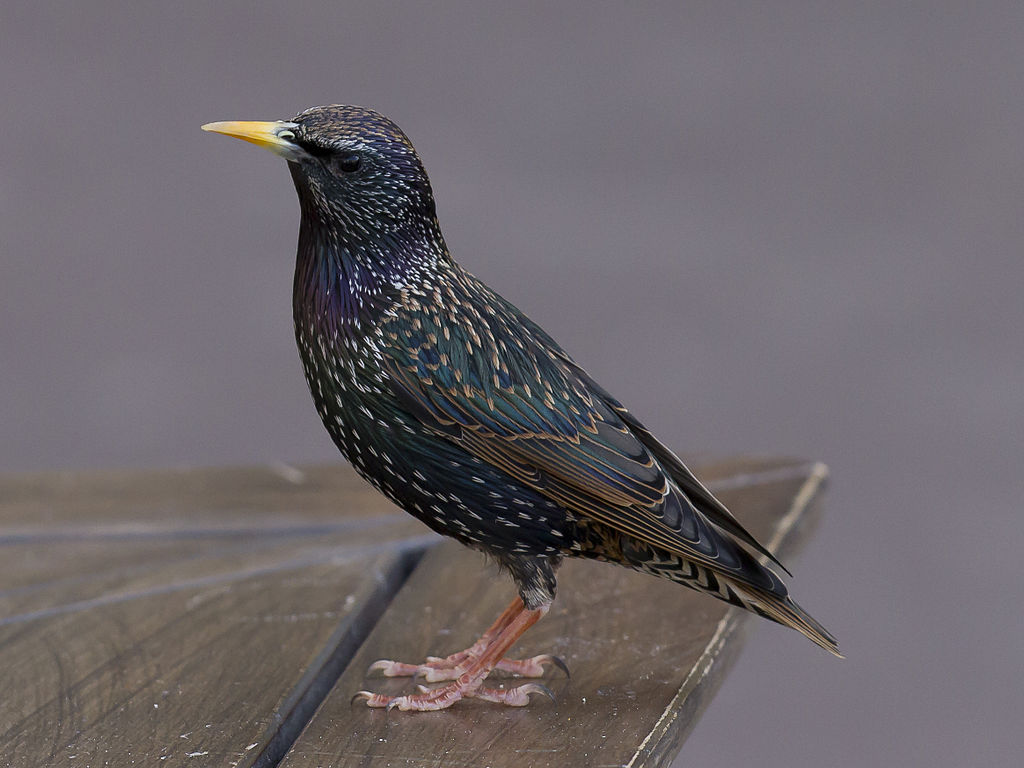
Coloration and Markings: European Starlings are not black, as they might appear from a distance, but rather a purplish green color that is shiny and quite lovely to view up close. They have long, pointy wings which makes their tails look quite shot by comparison and facially, the only break in the purple-green color is to be found in the form of a long, straight yellow bill. In winter these birds are no less stylish, in their chill-plumage outfits of brown with lovely white spots.
Size: Roughly Robin-sized, these birds measure in at 7.9 – 9.1 inches in length and have wingspans of 12.2 to 15.8 inches.
Habitat: European Starlings are comfortable in places with people and it’s no wonder. Every single one that you see in North America is a descendant of 100 birds that were released in New York in the late 1800’s. Shakespeare fans were to blame, but as a result you will see these birds in farms, towns, and cities, perched on a fence or a phone line as they look to see what we have dropped or left conveniently out for them.
Diet: These birds love suet so leave out plenty and you won’t have to add anything else. If their love of suet becomes problematical, however (and these birds will stay until it is done, so they might be a problem), then you can invest in a Starling-proof feeder and leave them out some peanuts and Black Oil Sunflower seeds. This will still make them happy and you can save some suet for some other species of birds visiting your backyard.
Downy Woodpecker – Picoides pubescens
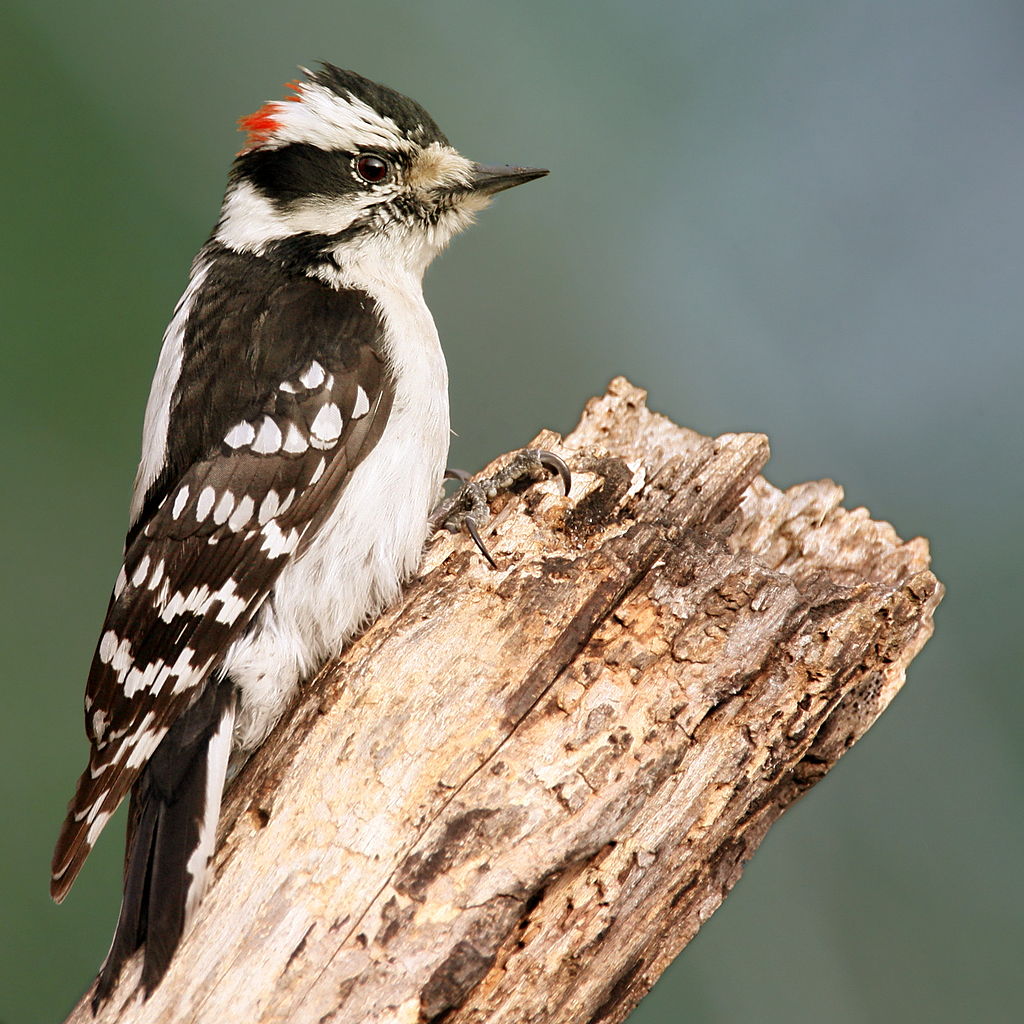
Coloration and Markings: Downy Woodpeckers are small but have a coloration that will definitely get your attention. With a broad, white stripe coloring the back, these birds have long, black wings with some striping present starting just under the shoulder which consists of white, squares that give the stripes a checkerboard feel. They have short, stout tails which are black on top and snowy-white underneath, and this white continues up the underbelly and breast and into the face. Facially, this white is only broken in a few places, those being a black mustache line, the bird’s black mask-band which extends to the back of the head, and a black cap which is completely black for females but with males, will exhibit a distinctive red spot towards the back of the head. These birds have thin, medium length black bills.
Size: The smallest North American Woodpecker, Downies measure in at 5.5 – 6.7 inches from tip to tail and have wingspans of 9.8 to 11.8 inches.
Habitat: These birds love areas which are open and also have brush or scrub cover. They are bold little birds as well, frequently visiting parks, gardens, and backyards as they forage for yummy snacks.
Diet: These little omnivores are easy to please, eating all kinds of seeds, berries, and even suet from local feeders. They also have a sweet tooth for crunchy peanut butter which they’ll wash down with a sip of sugar-water from your Hummingbird feeder.
Maryland’s Birds of Spring, Summer, and Early Fall
Cherry trees and raspberry bushes are probably the most conspicuous, in-your-face proof that spring has arrived in the beautiful state of Maryland. From spring until early fall another color palette is present but quite mobile, as our winged friends migrate in and settle down to stay for a bit. See if you can spot one of these birds during the warms months and the beginning of their decline:
- Red-eyed Vireo
- Chipping Sparrow
- Indigo Bunting
- Louisiana Waterthrush
- Yellow-billed Cuckoo
Red-eyed Vireo – Vireo olivaceus
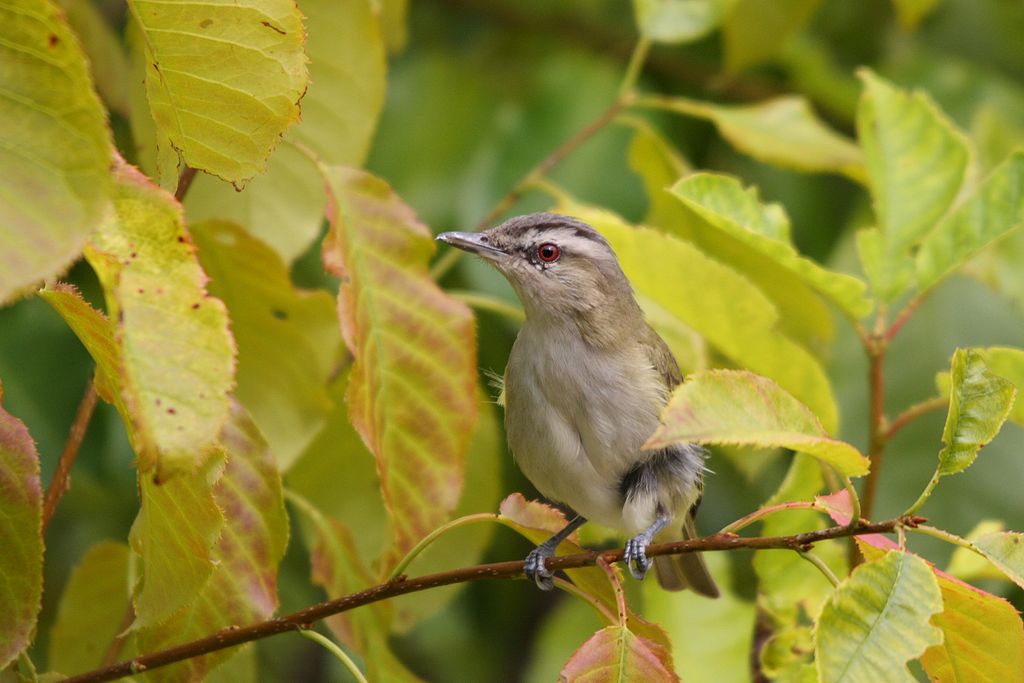
Coloration and Markings: Red-eyed Vireos have olive green backs and medium-length, olive green wings which have some grays present in the shoulders and the wingtips. They have long, perky olive tails with a little gray highlighting and white they are white from the rump to the lower half of the face there will be some light olive coloration present in the flanks and just under the tail. Facially, this bird has a mostly olive-colored face but with white in the chin, as well as white on top and below a thin, olive eyeline. Above this eyeline is a black eyebrow mark that makes the bird look like it is angry and the top of the head has a silver crown. These birds have long, black and silver bills with a noticeable, but small hook at the tip. Only adults will actually have the red eyes.
Size: These birds measure in at 4.7 – 5.1 inches in length and have wingspans of 9.1 to 9.8 inches.
Habitat: These birds favor deciduous woods and trees within with large leaves for optimal cover. When it’s warm you can also find them in parks, woodlots, and open meadows.
Diet: Red-eyed Vireos normally eat caterpillars and other insects but you can occasionally tempt them with suet and chopped apples (or other fruits that you might have around).
Chipping Sparrow – Spizella passerina
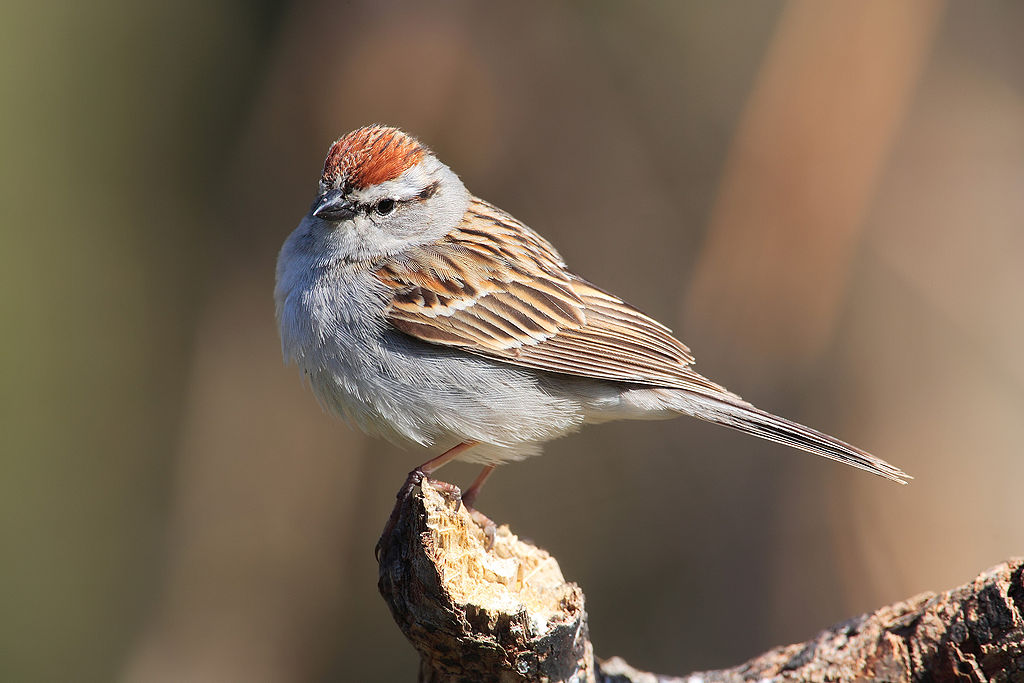
Coloration and Markings: Chipping Sparrows have tan brown backs with darker brown to black streaking present and this is also visible on their medium length wings though you will often see more gray on their long tails. The breast and underbelly of this bird are a velvety gray, sometimes with a little buff dimly visible, and facially, they have mostly gray faces, with a white mustache line that frames the cheeks, as well as a white line coming straight down from the back of the bill. They also have a thin, black eyeline which zigzags like a division sign towards the back of the head. Above this is a large, white eyebrow line and this bird has a rusty-red crown that has a touch of black towards the bill and which looks like a little red mohawk. These birds have medium length, conical black or yellowish bills.
Size: These Sparrows measure in at 4.7 – 5.9 inches in length and have wingspans of approximately 8.3 inches wide.
Habitat: These birds like open, wooded areas with high grass and weeds. Look for them in meadows and clearings if you are hiking out in the wild or in parks or backyards in your town or city.
Diet: Cracked corn, rolled oats, and mealworms are all favorites of the Chipping Sparrow that might just lure one or more of these little angels to your feeders.
Indigo Bunting – Passerina cyanea

Coloration and Markings: Male Indigo Buntings are stunning and easy to identify. They are a brilliant light indigo blue all over their bodies. They have medium length wings and long tails which sometimes show a little gray when the bird is molting and facially, you might notice a black line that goes to the front of the eyes and when the bird ‘puffs up’ a little you can almost see a tiny crest. Females will be a light to olive brown with light, streaked breast and underbelly and a whitish throat and the occasional blue tinges while Juvenile males will be a mix of blue and brown patches, with more and more blue as they get older. These birds have stout, medium-length, conical silver bills.
Size: These birds measure in at 4.7 – 5.1 inches in length and have wingspans of 7.5 to 8.7 inches.
Habitat: These Buntings are birds of brushes, brambles, thorns, shrubs, and scrubs. If there is a bit of cover to be found then you might just find a Bunting present in it.
Diet: Nyjer thistle is the easiest way to attract and keep the attentions of the Indigo Bunting.
Louisiana Waterthrush – Parkesia motacilla

Coloration and Markings: The Louisiana Waterthrush has a brownish-gray back, medium-length wings, and a short, grayish brown tail which is white on the undersides. The rump of this bird is white with a little light tan and gray coloration sometimes present while the underbelly and breast will be pale with brown streaking present. Facially, this bird is mostly grayish-brown, with a white, brown-streaked chin and throat, as well as a distinctive white eyebrow line and half of an eyering underlining the eyes. This bird has a long, capable black bill.
Size: These birds measure in at 5.9 – 6.1 inches in length and have wingspans of 9.4 to 10.6 inches in width.
Habitat: These birds are almost always found near rivers, streams, or ponds, where there is a little cover present in the form of shrubs or other dense vegetation.
Diet: In the wild these ground foragers eat a lot of insects, as well as crustaceans like crayfish. You might have a little luck with live mealworms but otherwise these birds are not generally interested in feeders.
Yellow-billed Cuckoo – Coccyzus americanus

Coloration and Markings: Yellow-billed Cuckoos have lovely coloration, with light brown backs and medium length wings which are light brown except towards the tips, where they show a lovely foxy reddish-brown. They have long, lovely grayish tails with distinctive white spotting down the sides and the breast and underbelly of this bird are paper white. This white extends up to the underside of the bill, taking up the throat and cheek area of the face, while the remaining color on the top and back portions of the head are a warm, light brown. These birds have long, curved yellow bills that often have some black at the tip and look like a lot like a lot like tiny bananas!
Size: These are sizable birds, measuring in at 10.2 – 11.8 inches from head to tail and having wingspans of 15 to 16.9 inches in width.
Habitat: These birds love clearings and meadows in deciduous areas, where they can ‘coo’ from the safety of canopies up high.
Diet: Yellow-billed Cuckoos can sometimes be tempted with a suet feeder.
Maryland’s Fall and Winter Birds
With winter lows of 16 degrees Fahrenheit, only the toughest birds stick around and it is every birder’s responsibility to help a feathered brother out. Be sure to leave out some snacks or even a heated birdbath in the backyard to show your support and appreciation to these birds this winter:
- Dark-eyed Junco
- Northern Mockingbird
- Mourning Dove
- White-breasted Nuthatch
- White-throated Sparrow
Dark-eyed Junco – Junco hyemalis

Coloration and Markings: Dark-eyed Junco coloration can vary a bit from region to region but typically you will see a dark brown or grayish back, with medium-length wings and long tails of the same color which will be white on the undersides. The rump, underbelly, and breast of this bird are white but with a heavy flanking of the gray or brown color present which is widest at the breast. This often gives an impression of an even amount of white across the lower body when the bird is at rest. The gray or brown is slightly richer in color in the face and these birds have stout, medium-length pink bills.
Size: These birds measure in at 5.5 – 6.3 inches in length and have wingspans of 7.1 to 9.8 inches.
Habitat: When it is warm these birds will mostly be found in coniferous or mixed coniferous woods. Once winter comes around, however, all bets are off, and these birds range out into fields, parks, and backyards as they forage for a little fuel to keep the cold at bay.
Diet: Cracked corn and hulled Black Oil Sunflower seeds are best with the Dark-eyed Junco, though it will occasionally take some suet if you’ve put it in a ground feeder.
Northern Mockingbird – Mimus polyglottos

Coloration and Markings: Northern Mockingbirds have grayish-brown backs, with short grayish wings which have some black highlighting and present in a banded pattern with 2 white wingbars present. When in flight, large white patches are also visible, and these birds have long, gray and black tails with white edging. The breast and underbelly of this bird are white and facially, this bird has a white chin with a small tuft of white above the bill as well as white cheeks with some gray peppered in. A light gray mustache line is present and a light gray eyeline goes through the eyes and curves around to frame the cheek as well. The top and back of the head are soft gray and this bird has a medium-length, straight black bill with a slight curve displaying on the upper half.
Size: These birds measure in at 8.3 – 10.2 inches in length and have wingspans of 12.2 to 13.8 inches wide.
Habitat: When they aren’t spending time at the forest’s edge or in open meadows these birds are quite at home in the city. Look for them on fences or phone lines or in backyards with well-stocked feeders.
Diet: While they turn their beaks up at seeds, suet and assorted fruits can earn you the attentions of the Northern Mockingbird.
Mourning Dove – Zenaida macroura
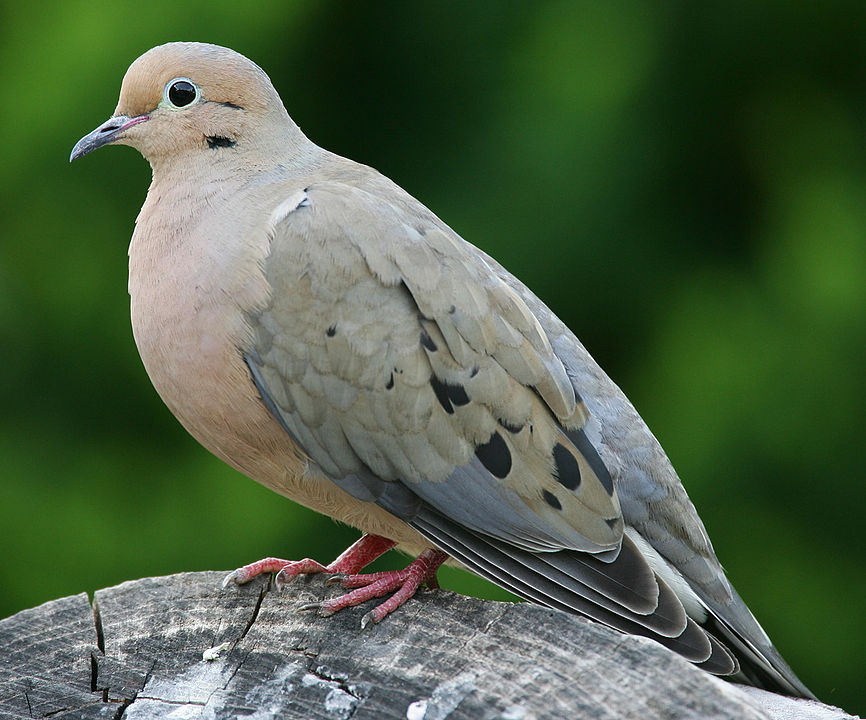
Coloration and Markings: Mourning Doves are light brown or gray with large wings which have a deep tan coloration towards the center with some distinctive black spots as well. They have long, thin and pointy gray tails and the breast and underbelly of this bird will be white with a heavy mix of creamy tan. Facially, the tan coloration is at its height and this makes the bird’s white eyering quite easy to spot. These Doves also have medium-length, thin, and straight black bills.
Size: These birds measure in at 9.1 – 13.4 inches in length and have wingspans of approximately 17.7 inches.
Habitat: These birds don’t like the deep forest, opting instead for fields or simply any wide, open areas where they might forage. They are quite urbanized and not shy about waddling down the sidewalk in the city so keep an eye out and you might just spot a Mourning Dove.
Diet: Mourning Doves like Nyjer thistle and will eat the occasional suet as well.
White-breasted Nuthatch – Sitta carolinensis

Coloration and Markings: The White-breasted Nuthatch has a bluish-gray back with long, bluish-gray wings which have some black edging present and some white and a thin, hard to see white wingbar. They have short, blue gray tails and the breast and underbelly of this bird are a snowy white but look towards the rump for a distinctive brown mark. The white from the breast extends up into the face, where it is broken only by a thin, angled black line coming from the back of the eye and a thin, black cap that extends down to the back and starts briefly towards the shoulders. These birds have long, thin black and white bills which are typically straight but sometimes curve lightly upwards.
Size: These birds measure 5.1 – 5.5 inches in length and have wingspans of 7.9 to 10.6 inches.
Habitat: These birds may be found at the forest’s edge or inside the deep woods. They prefer deciduous areas and stands of Oak and Hickory as good examples of where you might find them. They do occasionally forage in coniferous woods as well but deciduous is their preference.
Diet: Suet, peanuts, and Black oil Sunflower seeds are all favorites of the White-breasted Nuthatch. Be sure to leave a little out this winter and you might just make a new friend!
White-throated Sparrow – Zonotrichia albicollis
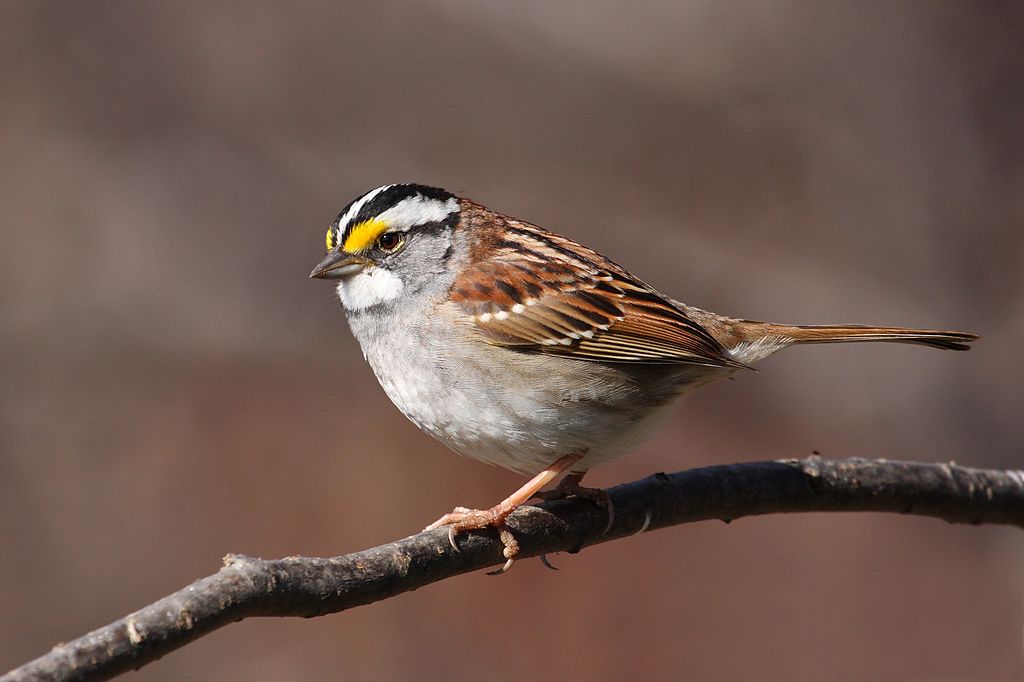
Coloration and Markings: White-throated Sparrows have light brown backs with dark streaking and this coloration is present on their medium-length wings which sport 2 thin, white wingbars if you look closely. They have long, brown tails with a little white edging, and the underbelly of the bird is white with a brown flanking and the coloration becomes gray as it moves up to the breast. Facially, these birds have gray faces with a small, white bib and a thin, black eyeline which curves up lightly and terminates at the back of the head. Above this is an enormous, white eyebrow line and this is topped off with black and a white center stripe at the top of the head, rather like a skunk’s markings. These birds have small, stout, and conical silver bills. Be on the lookout for the ‘tan striped’ variety of this bird as well, which has brown on the upper ‘skunk’ portion rather than black.
Size: These birds measure in at 6.3 – 7.1 inches in length and have wingspans of 7.9 to 9.1 inches.
Habitat: These birds like to be near water, so you can sometimes spot them near bogs, ponds, and streams, but they are also fond of the forest’s edge and clearings. When it gets gold, they prefer a little brush cover but they will happily range out into parks in cities and to the occasional backyard.
Diet: White Proso millet and Black Oil Sunflower seeds are the best combination for this bird but it is recommended that you employ a wide ground feeder, as this is how they like to forage. Sprinkle a bit of seed at the base for best results.
Supporting cast (Other Backyard Birds of Maryland that might pay you a visit)
While they aren’t the front page stars, our Supporting cast birds are celebrities that you know and love and they are there for you year-round as well. So leave some suet or apples out or simply spend a little time out of the house and see if you can glimpse one of these Supporting Stars:
- Song Sparrow
- Red-bellied Woodpecker
- American Robin
- Eastern Bluebird
- Carolina Chickadee
Song Sparrow – Melospiza melodia
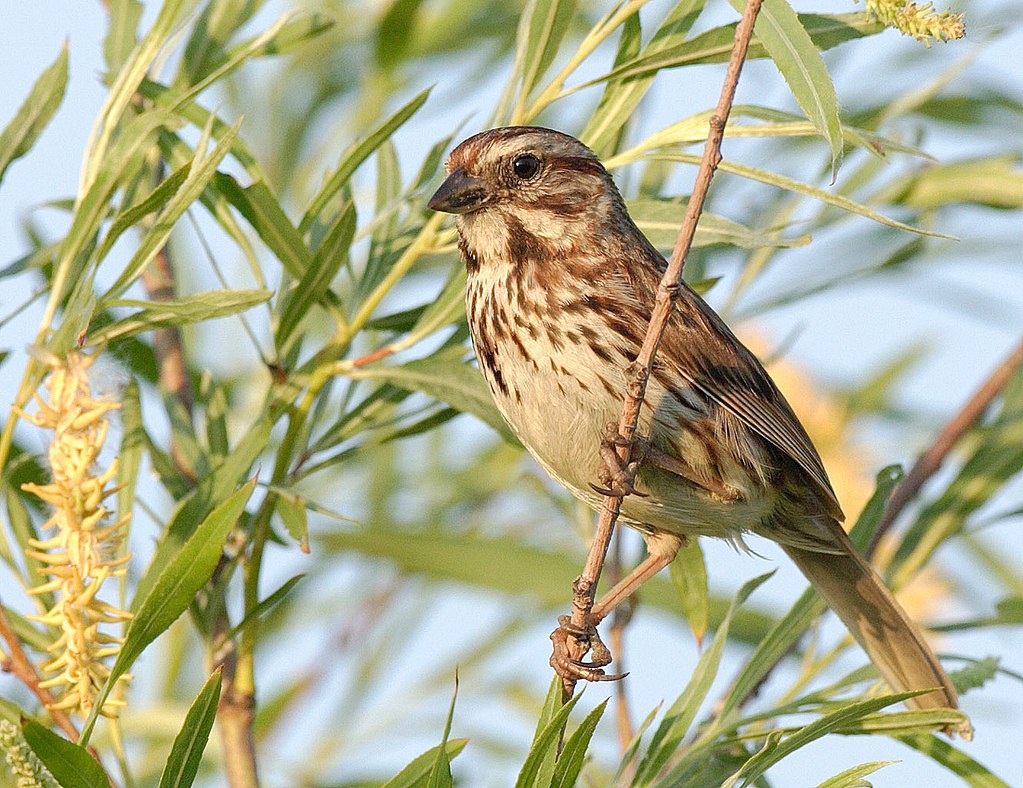
Coloration and Markings: Song Sparrows have warm, brown streaks with some touches of gray on their backs, their small, broad wings, and their long, brown tails. The breast and underbelly of this bird are gray with brown streaking and facially, these birds have a white mustache line and thin white eyerings, with a brown eyeline and gray typically above and below in broad swathes. They have grayish-white chins, warm brown caps, and small, stout, conical silver bills.
Size: These birds measure 4.7 – 6.7 inches from head to tail and have wingspans of 7.1 to 9.4 inches wide.
Habitat: These birds like open areas next to water but you can find them at the forest’s edge, desert areas, or overgrown fields. Look for a little scrub cover and you might find a Song Sparrow. They like to nest in the city so keep a little something in your feeder for them, especially around winter.
Diet: Shelled peanuts and suet are an easy combination for attracting the attentions of the Song Sparrow.
Red-bellied Woodpecker – Melanerpes carolinus

Coloration and Markings: Red-bellied Woodpeckers have zebra-striped backs and long wings, as well as short, stout striped tails. You might see some white patches near the wingtips when this bird flies but they are hard to spot. The breast and underbelly of this bird are white with splashes of red coloration and a red spot typically at the underbelly. Facially, these birds have mostly white, red-splashed faces, with a little red concentrated at the cheeks and with a brilliant red cap which continues down the back of the neck to terminate at shoulder level. These birds have long, stout, and straight black bills.
Size: These birds measure in at approximately 9.4 inches from tip to tail and have wingspans of 13 to 16.5 inches in width.
Habitat: These birds love the woods and are especially attracted to stands of Hickory and Oak. They are bold birds as well and range out into parks and backyards frequently as they forage for their meals.
Diet: Suet, chunky peanut butter, and chopped apples are all good choices for attracting this bird. Don’t be surprised if they take sips from your Hummingbird feeder as well as these guys definitely have a sweet tooth.
American Robin – Turdus migratorius
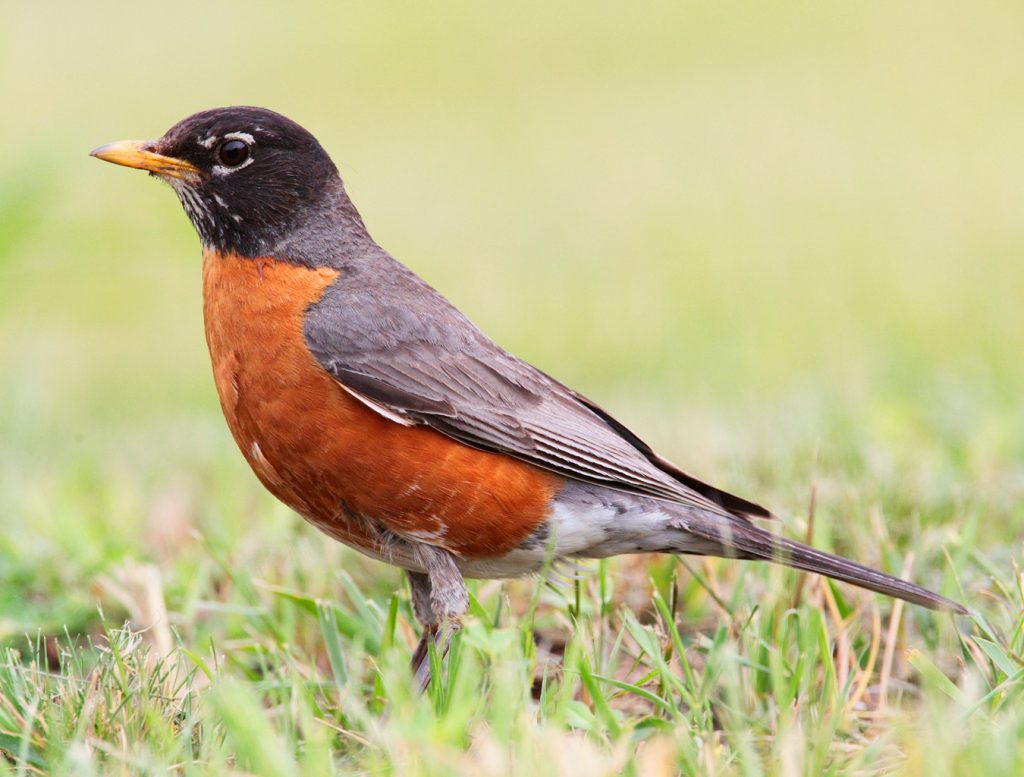
Coloration and Markings: American Robins have grayish-brown backs with long, grayish-brown wings and long grayish-brown tails with white edging present. The rump of this bird is white, however the underbelly and breast are a reddish orange color. Facially, these birds have black heads, with ‘broken’ white eyerings surrounding the eyes and often a small tuft of white underneath a medium length, slightly curved yellow bills. Females have a dimmer, muted coloration but are still quite easy to identify as Robins.
Size: These birds measure in at 7.9 – 11 inches in length and have wingspans of 12.2 to 15.8 inches in width.
Habitat: These birds love deciduous woods and also are quite fond of Pine forests in general. You can find them also in gardens, parks, pastures, and backyards, as these birds are quite bold and not so shy of humans.
Diet: Suet, crushed peanuts, and chopped apples are great, healthy snacks that you can leave out to attract and possibly keep the attentions of the American Robin.
Eastern Bluebird – Sialia sialis
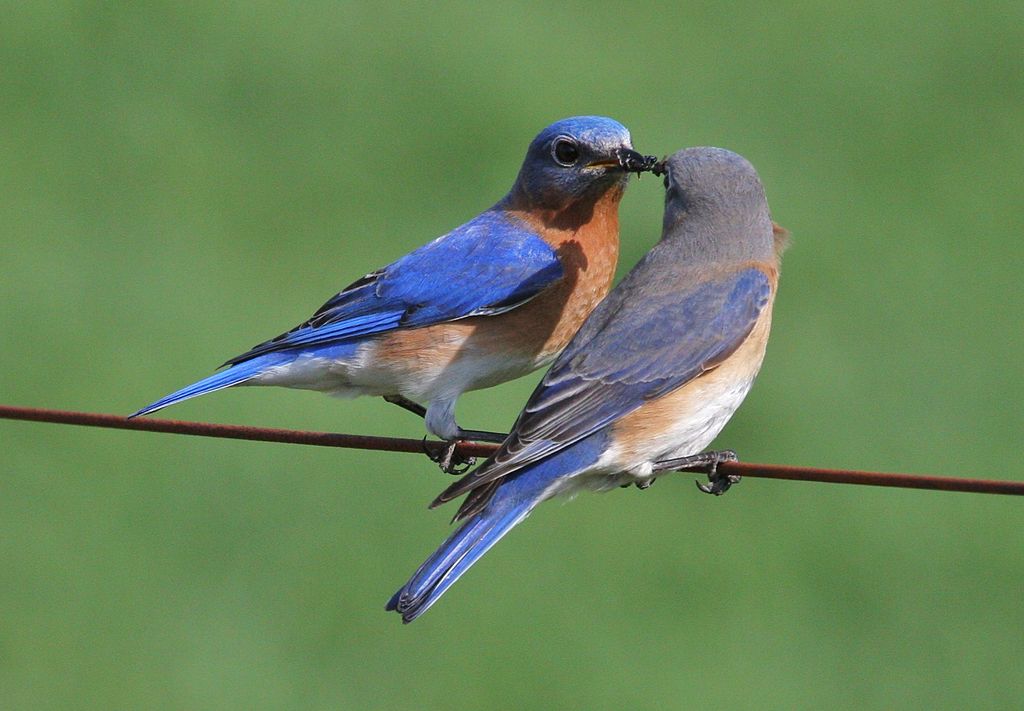
Coloration and Markings: Eastern Bluebirds are a deep blue on their backs, their long wings (sometim4es black tipped), and their short little tails. They have white rumps and white underbellies, although the underbelly with have a reddish-brown flanking that increases in thickness so that the bird has a reddish-brown breast. This coloration goes up to the base of the throat, where is spreads vertically to terminate at the back of the head, and facially you will see a thin line of reddish-brown going up under the bill. The remainder of the face will be a striking blue and these birds have medium-length, slightly curved black or silver bills. Females will have gray above but the wings will still be somewhat bluish and the red-orange of the breast will be somewhat muted.
Size: These birds measure in at 6.3 – 8.3 inches in length and have wingspans of 9.8 to 12.6 inches in width.
Habitat: Eastern Bluebirds love open wooded areas, such as meadows and clearings, and especially when you see knotholes and other places where they might nest. They are quite receptive to nest boxes, just in case you might like a new tenant in your backyard!
Diet: Suet, chopped apples, mealworms, and even eggshell bits will be consumed happily by the Eastern Bluebird, so be sure to leave one or more of these out for the winter to help these little guys and gals out.
Carolina Chickadee – Poecile carolinensis
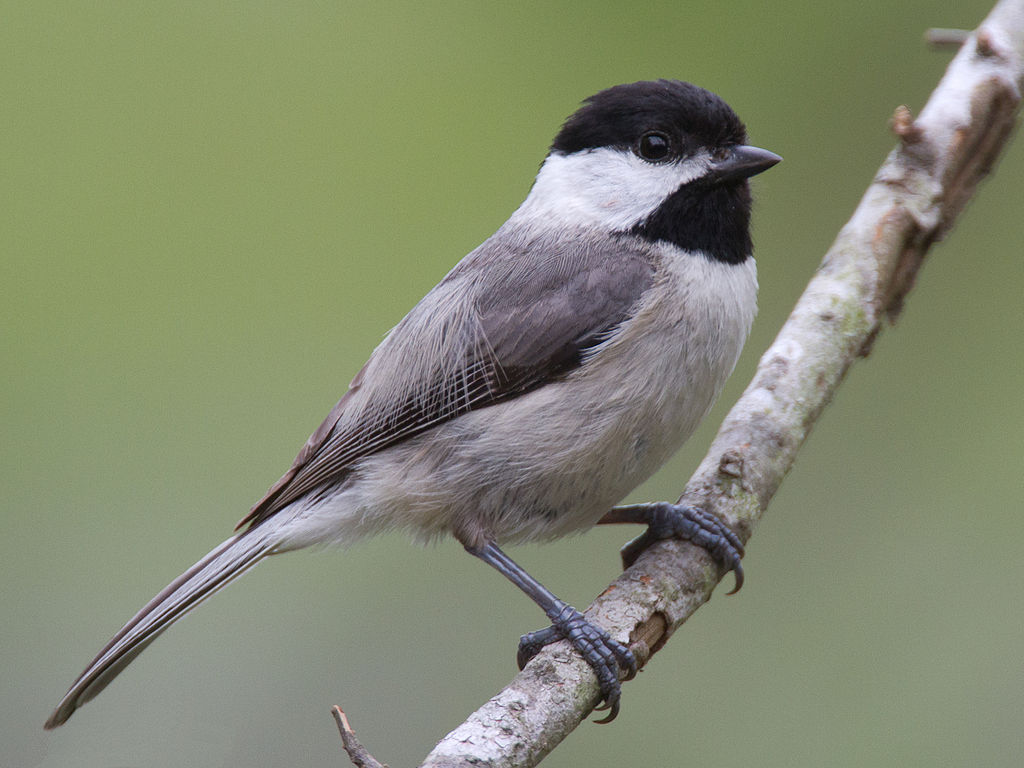
Coloration and Markings: Carolina Chickadees have light gray backs with short, gray wings and long, gray tails. They have a white breast and underbelly and white faces as well, with the exception of a small, black bib and a large, black cap which takes up the top half of the head and terminates about mid-eye level. These birds have small, thick, and conical black bills.
Size: These diminutive birds measure in at 3.9 – 4.7 inches in length and have wingspans of 5. To 7.9 inches.
Habitat: These birds like just about any type of woods but they are also quite comfortable in the city, where you can find them in parks or backyards.
Diet: Peanut butter and suet mixed together are a favorite of the Carolina Chickadee that you can easily put together. Give it a try and see what happens!
Maryland Bird buffet
When you are trying to create that perfect feeder for the local birds it always helps to have a little assistance from those in the know. In this case, we’ve compiled a few suggestions offered by the Maryland Department of Natural Resources and added a few of our own as well in order to help you find that perfect combination. They have some further advice on feeders so if you get curious and want to read it then be sure to check our references. In the meantime, consider adding 1 or more of these items to your feeders:
- Black Oil Sunflower seeds
- Striped Sunflower seeds
- Safflower Seeds
- White Proso millet
- Fruit jelly
- Crunchy peanut butter mixed with suet, rolled in sunflower seeds
Maryland Birding Hot Spots
The Chirparazzi know all the great places for tracking down those elusive winged stars of Maryland and will be sharing that information today. If you want to get a glimpse or catch a lucky photo then we have locations at the compass points and in the center of the state that might help you to do just that. If you don’t find anything close then be sure to check our reference link as there is always a nice birding spot just around the corner. Check out one of these hotspots when you have some free time and the inclination:
- Northern hotspot – Torrey C. Brown Rail Trail
- Eastern hotspot – Easton Rails-to-Trails
- Southern hotspot – St. Mary’s River State Park
- Western hotspot – Goldmine Loop Trail
- Central hotspot – WB&A Trail
Detailed descriptions of each location as well as information regarding visiting and what birds you can see at these locations may be found at https://www.traillink.com/stateactivity/md-birding-trails/
In Closing
Today we have taken a brief dip in the deep pool that is the Maryland Birding experience. With 436 species flitting about the state we imagine that Maryland birders are quite happy and we sure hope that pictures will be taken so that the love can be shared with other birders. We wish our birding friends in Maryland the best and advise anyone in a state close by to consider a visit. It’s a great state for birding in!
